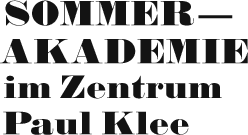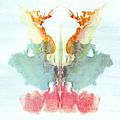The Rorschach-Test
1921 Hermann Rorschach developped the so-called Rorschach-Test. In his view the subjective answers to his "inkblot images," allow conclusions about perception, intelligence, and emotional characteristics of the subjects studied.
Firstly he experimented with various inkblots which he called " Klexographien " (roughly "blotographs ") his subjects being patients and employees of the Herisau clinic. The final result was a set of ten blots which had proved especially suited to his requirements, which he designated as his conclusive series, and which he had mounted onto card board. He would hand the cards one after the other to the subject each time posing the question, "What could this be?"
The answers were recorded and evaluated according to the following mainly formal criteria:
- Was the blot seen and interpreted as a whole or in its parts?
- Was the answer determined by only the form of the blot, or did the colours
and possibly imagined movements have an influence?
- What was seen?
Rorschach weighted the formal criteria such as interpretation of the whole or of the parts, or the influence of form, colour and movement more heavily than the factual content of the answers. For his evaluation he used a statistical procedure to compute the formal factors and content according to their recorded frequency and to their interrelationships.
He observed that the subjects approached the task in very different ways: The manner in which they interpreted the indeterminate blots appeared to be dependent on particular personality characteristics, and the evaluation of those results indicated that typical behaviour patterns could be associated with particular groups of people, e.g. persons from the normal population with different talents or levels of intelligence, or various patient groups such as schizophrenics, epileptics and maniac-depressives .
Rorschach was not the first to employ inkblots for scientific experimental purposes. As early as 1895 doctors and psychologists had applied inkblots for the assessment of imagination in the context of intelligence testing of children.
The Rorschach-Test is controversial. His supporters assess it as a quality test procedure that allows an in-depth assessment of the overall personality. His critics miss the reliability.
As separate surveys of clinical psychologists in the USA and of clinical and other professional psychologists in West Germany, both in 1995, show, the Rorschach-Test and the projective methods belong even now in the repertoire of many psychologists. In Switzerland one encounters the Rorschach-Test mainly in clinical psychology and psychiatry. Further important applications are in the selection of personnel and in vocational or career guidance.
The "Rorschach-Test" in the context of art
Not pul off by the scientific controversy surrounding the Rorschach-Test, artists and art historians continue to exhibit keen interest in Rorschach's inkblots; down through the centuries random images and the underlying perceptual phenomena have played an ever increasingly important role in art. No wonder that art historians concern themselves even today with chance images. In the works of modern contemporary artists such as Andy Warhol, Morris Louis and Elspeth Lamb we find more or less explicit references to Rorschach's blots.
1957 the Rorschach-Archive was initiated and is run by the University Library Bern, Switzerland.
(Excerpts from: Rita Signer, Archiv und Sammlung Hermann Rorschach, ed. of the University Library Bern, Verlag Hans Huber, Hogrefe AG, Bern.)






